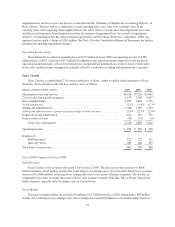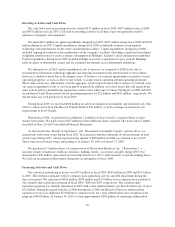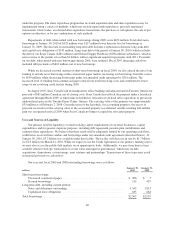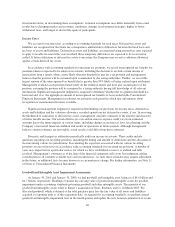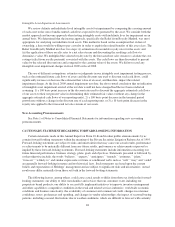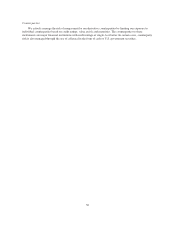Sears 2009 Annual Report Download - page 44
Download and view the complete annual report
Please find page 44 of the 2009 Sears annual report below. You can navigate through the pages in the report by either clicking on the pages listed below, or by using the keyword search tool below to find specific information within the annual report.
Other Commercial Commitments
We issue various types of guarantees in the normal course of business. We had the following guarantees
outstanding as of January 30, 2010:
millions
Bank
Issued
SRAC
Issued Other Total
Standby letters of credit .............................................. $662 $ 67 $— $729
Commercial letters of credit ........................................... 18 106 — 124
Secondary lease obligations and performance guarantee .................... — — 19 19
The secondary lease obligations relate to certain store leases of previously divested Sears businesses. We
remain secondarily liable if the primary obligor defaults.
Application of Critical Accounting Policies and Estimates
In preparing the financial statements, certain accounting policies require considerable judgment to select the
appropriate assumptions to calculate financial estimates. These estimates are complex and subject to an inherent
degree of uncertainty. We base our estimates on historical experience, terms of existing contracts, evaluation of
trends and other assumptions that we believe to be reasonable under the circumstances. We continually evaluate
the information used to make these estimates as our business and the economic environment change. Although
the use of estimates is pervasive throughout the financial statements, we consider an accounting estimate to be
critical if:
• it requires assumptions to be made about matters that were highly uncertain at the time the estimate
was made, and
• changes in the estimate that are reasonably likely to occur from period to period or different estimates
that could have been selected would have a material effect on our financial condition, cash flows or
results of operations.
Management believes the current assumptions and other considerations used to estimate amounts reflected
in the financial statements are appropriate. However, if actual experience differs from the assumptions and the
considerations used in estimating amounts, the resulting changes could have a material adverse effect on our
consolidated results of operations, and in certain situations, could have a material adverse effect on our financial
condition.
Management has discussed the development and selection of these critical accounting estimates with the
Audit Committee of our Board of Directors and the Audit Committee has reviewed the disclosure presented
below relating to the selection of these estimates.
The following is a summary of our most critical policies and estimates. See Note 1 of Notes to Consolidated
Financial Statements for a listing of our other significant accounting policies.
Valuation of Inventory
Our inventory is valued at the lower of cost or market determined primarily using the retail inventory
method (“RIM”). RIM is an averaging method that is widely used in the retail industry. To determine inventory
cost under RIM, inventory at its retail selling value is segregated into groupings of merchandise having similar
characteristics, which are then converted to a cost basis by applying specific average cost factors for each
grouping of merchandise. Cost factors represent the average cost-to-retail ratio for each merchandise group based
upon the fiscal year purchasing activity for each store location. Accordingly, a significant assumption under the
retail method is that inventory in each group is similar in terms of its cost-to-retail relationship and has similar
44



